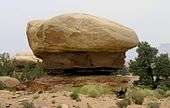Cutler Formation
The Cutler Formation or Cutler Group is a rock unit that is spread across the U.S. states of Arizona, northwest New Mexico, southeast Utah and southwest Colorado. It was laid down in the Early Permian during the Wolfcampian stage. Its subunits, therefore, are variously called formations or members depending on the publication. Members (youngest to oldest):[1][2]
- De Chelly Sandstone (Arizona, Colorado, New Mexico, Utah)
- White Rim Sandstone (Utah)
- Organ Rock Shale (Arizona, Colorado, New Mexico, Utah)
- Cedar Mesa Sandstone (Arizona, Utah)
- Elephant Canyon Formation (Utah)
- Halgaito Shale (Arizona, Colorado, New Mexico, Utah)-(oldest)
| Cutler Formation Stratigraphic range: Early Permian | |
|---|---|
| Type | Geological formation |
| Sub-units | De Chelly Sandstone, White Rim Sandstone, Organ Rock Shale, Cedar Mesa Sandstone, Elephant Canyon Formation, Halgaito Shale[1][2] |
| Underlies | Chinle Formation |
| Lithology | |
| Primary | iron-rich arkose sandstone |
| Location | |
| Region | Colorado Plateau |
| Country | |
| Extent | |
| Type section | |
| Named for | Cutler Creek, north of Ouray, Co |
| Named by | C.W. Cross and Ernest Howe |
| Year defined | 1905 |
Extent
There is no designated type locality for the Cutler. It was named by Cross and Howe in 1905 after Cutler Creek, which enters Uncompahgre River about 4 miles north of Ouray, Colorado.[3] Baker and Reeside revised Cross and Howe's work in 1929 by dividing the formation into the Halgaito Tongue (base), Cedar Mesa Sandstone Member, Organ Rock Tongue, and White Rim Sandstone Member. Cutler's geographic extent was established by Wood and Northrop in 1946. In 1958 Wengerd and Matheny raised the formation to group rank.

Geology
Cutler outcrops are found in these geologic locations in Arizona, Colorado, New Mexico and Utah.
References
- "Geology of Canyonlands National Park" (PDF). National Park Service, U.S. Department of the Interior. Retrieved 30 September 2018.
- "Stratigraphy of Canyon de Chelly National Monument". Geology of National Parks, 3D and Photographic Tours. United States Geological Survey. Retrieved 30 September 2018.
- Keroher, Grace C., Lexicon of Geologic Names of the United States for 1936-1960, Part 1, p. 1019, at Google Books
- Cross, C.W. and Howe, Ernest, 1905, "Geography and general geology of the quadrangle, IN Description of the Silverton quadrangle [Colorado]", U.S. Geological Survey Geologic Atlas of the United States, Silverton folio, no. 120, 34 p.
- Baker, A.A. and Reeside, J.B., Jr., 1929, "Correlation of the Permian of southern Utah, northern Arizona, northwestern New Mexico, and southwestern Colorado", American Association of Petroleum Geologists Bulletin, v. 13, no. 11, p. 1413-1448
- Wood, G.H. and Northrop, S.A., 1946, "Geology of Nacimiento Mountains, San Pedro Mountain, and adjacent plateaus in parts of Sandoval and Rio Arriba Counties, New Mexico", U.S. Geological Survey Oil and Gas Investigations Map, OM-57, 1 sheet, scale 1:95,040
- Wengerd, S.A. and Matheny, M.L., 1958, "Pennsylvanian system of the Four Corners region", American Association of Petroleum Geologists Bulletin, v. 42, no. 9, p. 2048-2106